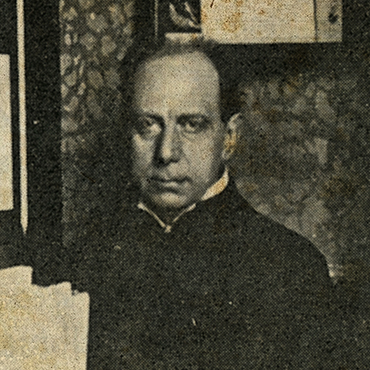Dino Giovannozzi (his real name), was born in 1860 in Florence in a well-off family. He received his primary education first at home and then at the Istituto Graziani in Florence; then in 1872 he became a pupil at the Scuole Pie of San Giovannino under the guidance of Giuseppe Manni. As early as 1876 he became a novice at the convent of il Pellegrino and took his first vows in 1879, under the name of Giovanni. Within the Piarist Order his teachers were Celestino Zini, Mauro Ricci and Filippo Cecchi.
He subsequently attended the Istituto di Studi Superiori di Firenze, where he obtained the diploma in natural sciences as a student of Adolfo Targioni Tozzetti. In 1880 he was sent to complete his education at the Faculty of Science of the University of Rome, where he studied with Stanislao Cannizzaro and then graduated in chemistry the following year. Back in Florence, in 1882 he became a priest and rapidly advanced his career from primary school teacher to high school teacher of physics and chemistry at San Giovannino.
When Filippo Cecchi died suddenly in 1887, he took over the management of the Osservatorio Ximeniano in Florence. His interest in seismology and meteorology (he spent years even designing lightning conductors) led him to combine his research with intense work in publishing and promoting popular culture. He contributed to the modernisation of Catholic thinking (including on the subject of the theory of evolution) by adopting a progressive and conciliatory stance, derived from the teachings of Rosmini. He was accused of adhering ideas of modernism and liberalism, alongside Ermenegildo Pistelli and Tommaso Catani, but he avoided expulsion from the Order, as Pope Leo XIII had requested, only through the intervention of the Archbishop of Florence, Alfonso Maria Mistrangelo. He was, however, forbidden to teach religion, at least for a few years, and in 1905, during the pontificate of Pius X, also to preach. As a result, he focused on his studies of science and the history of science, remaining in charge only of the Cepparello in Via del Corso and of the Scuole Pie.
When his mother died, he suffered a nervous breakdown and spent a long period at Viareggio, leaving Guido Alfani in charge of the Osservatorio Ximeniano. He was soon reinstated and resumed teaching religion, although he was unable to prevent the closure for several years of the high school that was part of the Scuole Pie, a school that was considered to be uneconomic because of the small number of students. The promulgation by Pope Pius X of the encyclical Pascendi gregis against modernism, although it did not affect him personally, did influence his attempts at a conciliation between evolutionism and Catholic creationism, in that it caused a gradual weakening of his leanings towards Rosmini’s thinking. On the other hand, his work on science and the history of science was not affected, in that this activity drew strength also from his long collaboration with the “Rassegna nazionale”. As a result of his apologist articles and his teaching work, in 1911 he was awarded an honorary degree in theology and was appointed by the bishop as a member of the Collegio teologico fiorentino. At the beginning of the First World War he gave up the management of the Cepparello in order to dedicate himself to his studies; these took him to the archives in Florence, Pisa and Rome in search of documents on Galileo, on his own school and on the early Piarists of Florence, the results of which would bear fruit in later years. In 1917 he was asked to become a member of the Società italiana dei XL and of the Accademia pontificia dei Nuovi Lincei. In 1923 he was made Assistant General of the Piarists and he had to move to Rome, where he became an active contributor to its cultural life, so much so that the Fascist government made him a member of the committee that assessed textbooks for the teaching of religion. He returned to Florence for health reasons and died there in 1928.
Giovannozzi was very fond of Raffaello Caverni, whom he had met as a student in the corridors of San Giovannino, and became a close friend of his nephew Egisto, who made available to him Raffaello Caverni’s private archive. For the tenth anniversary of Caverni’s death he produced the biographical profile Un tedesco di Montelupo, which for many years has been the reference text for those interested in the life and work of Caverni.

